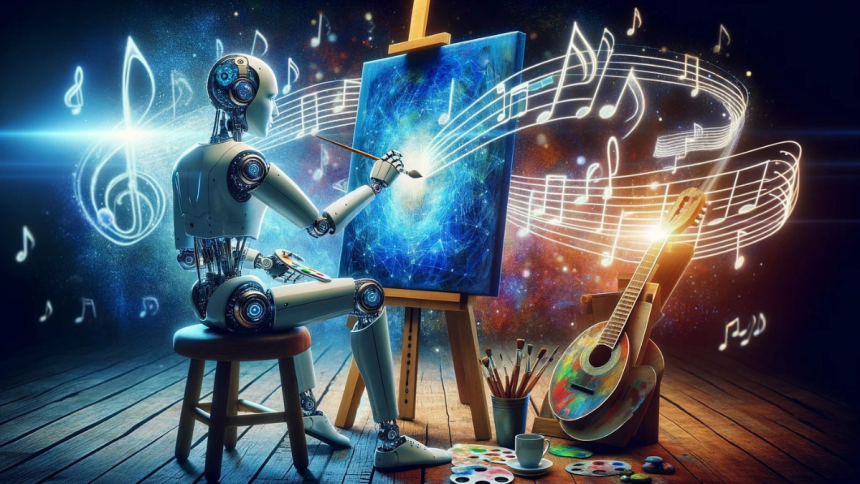The creative landscape is experiencing its most dramatic transformation since the digital revolution. Artificial intelligence has evolved from experimental novelty to essential creative partner, with 86% of professional creators reporting positive AI impacts on their work and productivity gains averaging 66% across creative functions. The global AI creative tools market reached $4.8 billion in 2024 and is projected to hit $21.6 billion by 2032, while leading platforms have generated millions of AI-powered creative works.
AI tools dominate creative disciplines The AI creative toolkit has matured rapidly across all major creative fields. Music creation has been revolutionized by tools like Suno AI, which generates complete songs from simple text prompts. For music videos specifically, Neural Frames stands out as the premier AI music video generator, offering timeline-based editing and serving major artists with flexible pricing tiers.
Video production has seen explosive growth with Runway Gen-3 Alpha setting quality standards for text-to-video generation. Platforms like Synthesia enable anyone to create professional videos with AI avatars, democratizing video creation for businesses of all sizes.
Visual arts showcase the most mature AI applications, with Midjourney commanding significant market share for artistic image generation. Adobe Firefly has positioned itself for commercial use with clear licensing, while Stable Diffusion provides open-source flexibility.
Writing assistance has achieved near-ubiquitous adoption through ChatGPT and specialized platforms, demonstrating how AI can reduce content creation time by up to 90% for many tasks.
Technical foundations Understanding AI creative technology illuminates both capabilities and constraints. Transformer models power text generation, processing information through attention mechanisms that consider entire contexts simultaneously. These excel at language tasks but struggle with factual accuracy.
Diffusion models drive image and video generation by progressively refining random noise into coherent visuals. This approach generates stunning high-resolution images but requires substantial computational resources and struggles with text rendering and consistent character generation.
Hardware requirements scale with ambition: basic AI art generation needs RTX 3060 graphics cards, while professional work benefits from RTX 4090 systems. Current limitations include character consistency challenges, physical world understanding gaps, and video generation limits under one minute.
Workflow transformation and democratization AI fundamentally restructures creative work. Content creation time has dropped 90%, from hours to minutes through AI-assisted ideation and automated iteration. Creative agencies report 70% production time reduction and 40% output increases without quality sacrifice.
This efficiency creates unprecedented democratization. Small businesses compete with major brands using AI-generated materials, achieving 35% cost reductions within months. Individual creators without technical backgrounds produce complex digital art, while musicians compose original music regardless of formal training.
The economic impact proves substantial: businesses report $3.7 ROI for every $1 invested in generative AI. New roles emerge – AI Art Directors, prompt engineers, and AI-human collaboration specialists – while traditional roles evolve rather than disappear.
Neural Frames: Audio-reactive innovation Neural Frames exemplifies specialized AI innovation in music video generation. The platform has generated over 1 million videos and offers unique stem extraction capabilities that create beat-synced visuals by isolating vocals, drums, bass, and instruments. This enables visuals that genuinely respond to musical elements rather than generic animations.
The 2024 integration of Runway Gen-3 Alpha elevated quality to professional standards, with timeline-based editing allowing precise control. Major artists including Die Antwoord and Linkin Park have adopted such AI video tools, demonstrating mainstream acceptance of AI-generated music videos.
Future developments and ethical considerations The trajectory through 2025-2026 centers on autonomous AI agents handling complex creative workflows with minimal oversight. Google’s Gemini 2.0 and Microsoft’s creative automation tools represent this evolution toward sophisticated, independent AI systems.
Ethical debates focus on consent, attribution, and economic justice. The most sustainable approaches emphasize explicit permission requirements and fair compensation models that balance innovation with creator rights.
Best practices for human-AI collaboration Successful AI integration treats AI as creative partner rather than replacement. Start with low-risk tasks like asset resizing and caption generation before scaling to complex applications.
Skill development prioritizes prompt engineering as foundational competency, followed by AI tool proficiency and quality evaluation abilities. There are AI recruitment platform helping our companies. The creators thriving in this landscape combine AI efficiency with human strategic thinking, emotional intelligence, and cultural context.
Conclusion
The evidence overwhelmingly supports a future where AI amplifies rather than replaces human creativity. The 86% of creators reporting positive AI impacts represent early adopters of technology that’s democratizing creative tools, accelerating workflows, and enabling new forms of expression. From Neural Frames’ audio-reactive music videos to 70% production time reductions across agencies, AI has proven its value as a creative multiplier.
The opportunity is clear: creative professionals who thoughtfully integrate AI tools while preserving their unique human perspective will define the next generation of creative excellence. The technology exists, the economic benefits are proven, and the creative possibilities are just beginning to unfold.
Lynn Martelli is an editor at Readability. She received her MFA in Creative Writing from Antioch University and has worked as an editor for over 10 years. Lynn has edited a wide variety of books, including fiction, non-fiction, memoirs, and more. In her free time, Lynn enjoys reading, writing, and spending time with her family and friends.















